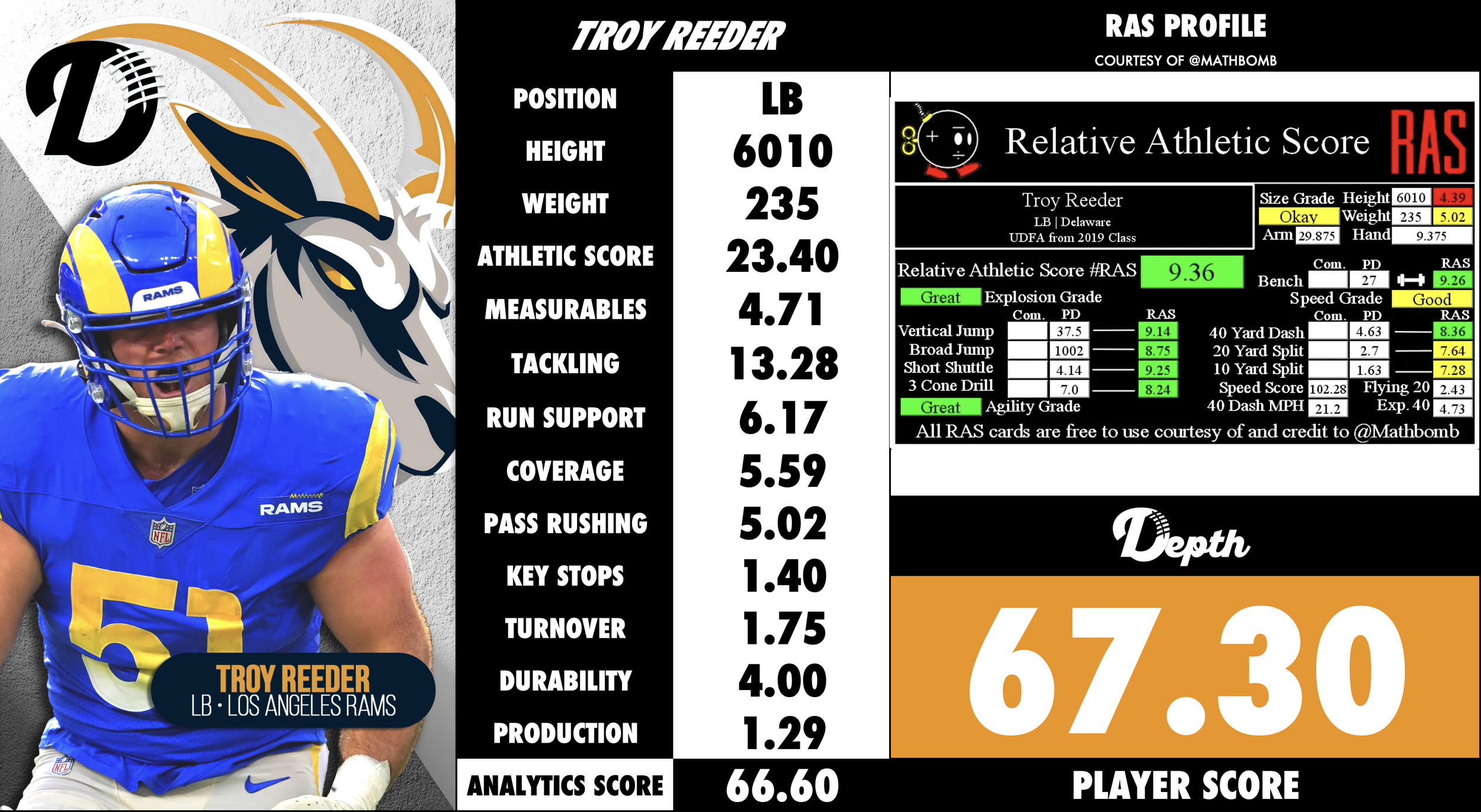
Troy Reeder
Summary
Troy Reeder went undrafted in the 2019 Class out of University of Delaware. Reeder entered the NFL as a high‑motor, instinct‑driven linebacker whose tape at Delaware showcased strong tackling production, good instincts in run‑support, and notable effort for an undrafted free agent despite beginning his collegiate career at Penn State. Standing approximately 6′3″ and around 230‑240 lbs, he projects as a dependable linebacker who can contribute on early downs and special teams, though he carries limitations in range, elite coverage burst and pass‑rush explosiveness.
Strengths
Tackling productivity and physicality near the line of scrimmage: Reeder consistently registers high tackle counts and fights through contact to finish runs.
Instincts and situational awareness: He has a strong feel for flow, diagnosing run vs. pass quickly and being in the right zone or gap—especially given his small‑school background.
Versatility and willingness to play multiple roles: Reeder has contributed on special teams, inside linebacker packages and has stepped up in varying defensive fronts.
High motor and strong character / competitive mindset: His journey as an undrafted player and his response in practices and games indicate relentlessness and ability to overcome odds. Los Angeles Rams
Good size for the position and proven durability: At 6′3″ and ~235 lbs he has adequate size for the interior linebacker role, and he made significant snap‑counts early in his career.
Weaknesses
Limited range and recovery speed in coverage: Reeder’s athletic profile is not elite in terms of long‑speed, which can limit him when asked to cover fast backs or shifting receivers in space.
Pass‑rush explosion and edge‑blitz repertoire modest: While solid against the run, his impact as a frequent blitz‑linebacker or disruptor in pass rush is more limited compared to premium edge‑linebacker prospects.
Block‑shedding and elite one‑on‑one physicality less refined: Against bigger linemen or when required to disengage blocks quickly, Reeder may not win the rep as often as more physically dominant players.
Ceiling somewhat tied to scheme and role specificity: Because his strengths lean toward tackling and instincts rather than elite athleticism, his highest upside may come in a role tailored to those attributes rather than as a three‑down every‑down “star” by physical measurables alone.
Workload and coverage responsibilities may expose limitations: If asked to play heavy snap counts in coverage‑heavy defenses or against many spread offensive sets, his limitations in speed and change‑of‑direction may become exposed.
Fit & Outlook
Reeder fits best in a defensive scheme that values physical, instinctive linebackers who excel in run‑support, gap discipline and tackling rather than those whose primary burden is to be a high‑volume coverage or blitz specialist. He is well‑suited for inside or “Mike” linebacker roles in 4‑3 or 3‑4 fronts where he can operate near the box, read plays, and contribute on early downs and special teams. In a system that rotates linebackers, uses sub‑packages, and asks him to fit between coverage‑cover demands, Reeder can carve a meaningful role. He may be less optimal in defenses that require their linebackers to consistently cover deep space, shadow fast backs or tight ends, or blitz aggressively on a large percentage of snaps. Looking ahead, his outlook is positive. His floor is that of a reliable rotational linebacker and special‑teams contributor—someone who can step in on early downs, make solid plays and be dependable. His upside, given his instincts, production mindset and versatility, is becoming a full‑time starter who can hold his own against the run, contribute decently in coverage and be a core defensive piece. The key to unlocking his full value will be consistent physical development, refining his coverage technique, and being placed in a scheme that accentuates his tackling and instinct strengths while minimizing match‑ups that demand elite speed or athleticism.


